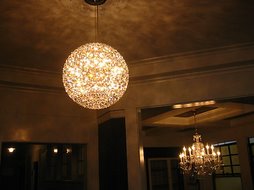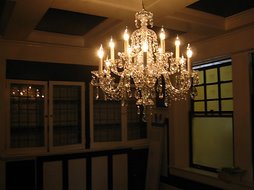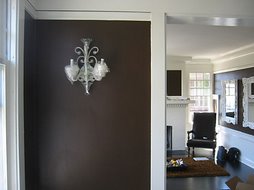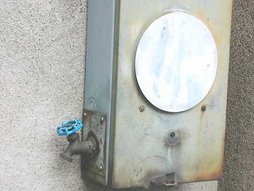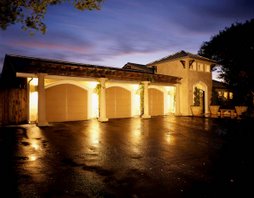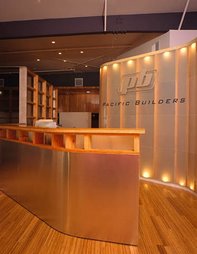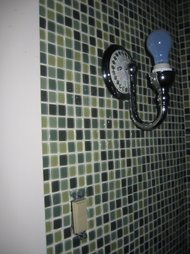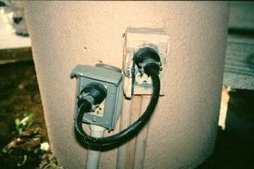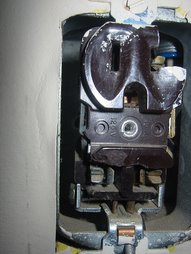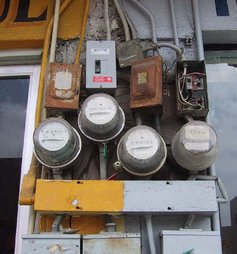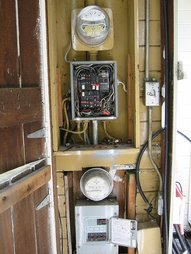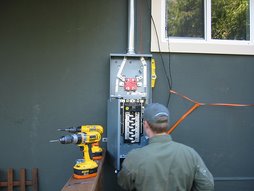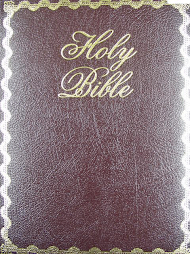Life safety, property and convenience.
People can show a cavalier disregard for the most basic safety measures.
Be careful with the use of extension cords
http://wr1.live/no-substitute
Improper use of extension cords and surge protectors can present a serious fire safety hazard in the workplace. According to the National Fire Protection Association (NFPA), electrical distribution equipment, such as extension cords were the second leading cause of fire deaths in the U.S. between 1994 and 1998. The most common cause of fires from extension cords is improper use and/or overloading, especially when the cord has multiple outlets. The 2007 California Fire Code Chapter 6 Section 605 addresses the use of extension cords, power taps, surge suppressors and multi plug adaptors.
By following the guidelines below the risk of fire due to overloaded or improperly used extension cords or surge protectors can be greatly reduced.
The problem with flexible cord used in extension cords it that the rubber used will deteriorate over time and become brittle and fall off. This can leave the conductors inside exposed to damage and possible failure of the insulation system which could lead to a fire. For this reason flexible cord can not be used as a substitute for the use of other permanent wiring methods
Flexible Cords, Cables and Fixture Wire
Understanding the wiring requirements of Article 400, including guidelines for flexible cords, cables, and fixture wire

.JPG&container=blogger&gadget=a&rewriteMime=image%2F*)
To prevent fires, be very careful with extension cords.
Avoid trip hazards.
Do not cover or walk on cords.
Plug extension cords into GFIs.
Test the GFI when you plug the cord in.
Always unplug cords at the source when not in use.
Do not use cord if damaged.
Inspect them as you roll them up and out.
No "Daisy Chain"
Do not plug one extension cord into another.
Completely connect plugs.
Push them in all the way.
Use three-wire extension cords with 3-pronged plugs
605.5 Extension cords. Extension cords and flexible cords shall not be a substitute for permanent wiring. Extension cords and flexible cords shall not be affixed to structures, extended through walls, ceilings or floors, or under doors or floor coverings, nor shall such cords be subject to environmental damage or physical impact. Extension cords shall be used only with portable appliances.
Regarding temporary power taps, the UL white book is quite clear,
"...Relocatable power taps are not intended to be permanently secured to building structures, tables, work benches, or similar structures, nor are they intended to be used as a substitute for fixed wiring.
http://wr1.live/no-substitute
Improper use of extension cords and surge protectors can present a serious fire safety hazard in the workplace. According to the National Fire Protection Association (NFPA), electrical distribution equipment, such as extension cords were the second leading cause of fire deaths in the U.S. between 1994 and 1998. The most common cause of fires from extension cords is improper use and/or overloading, especially when the cord has multiple outlets. The 2007 California Fire Code Chapter 6 Section 605 addresses the use of extension cords, power taps, surge suppressors and multi plug adaptors.
By following the guidelines below the risk of fire due to overloaded or improperly used extension cords or surge protectors can be greatly reduced.
- Approved Extension Cords Must:
- Be Underwriter Laboratories (UL) listed.
- Be at least 12-14 gauge wire and not be less than the rated capacity of the appliance.
- Have a ground wire and cannot be bypassed or rendered inoperable.
- Be used only for temporary situations, such as laboratory experiments lasting no longer than 90 days, and not be used in place of permanent wiring.
- Connect to only one portable appliance. Portable means easily moved from one place to another during use.
- Connect directly into a wall receptacle.
- Be protected from exterior damage. Examples include
- environmental (weather) and
- physical (foot traffic).
- Be longer than 100 feet.
- Have more than one receptacle on each end.
- Be frayed, deteriorated, spliced or modified.
- Pass through walls, doors or windows.
- Be stapled or attached to a floor, wall, or ceiling.
- Be connected in series.
- Create a tripping or other safety hazard.
- Be unprotected where exposed to foot traffic, moving wheels, or falling debris to minimize tripping hazards and damage to the cords.
- Be in a cable tray that is not intended for power
In most cases, hard pipe and new circuits are required for safety. The bottom line is that extension cords are never OK , but temporary power taps Can Be OK under certain circumstances.
restricted in use to only a number of low powered loads, such as computers, peripherals, audio/video devices or laboratory test equipment. High power loads such as space heaters and kitchen-type appliances shall be directly plugged into a wall receptacle
The problem with flexible cord used in extension cords it that the rubber used will deteriorate over time and become brittle and fall off. This can leave the conductors inside exposed to damage and possible failure of the insulation system which could lead to a fire. For this reason flexible cord can not be used as a substitute for the use of other permanent wiring methods
Flexible Cords, Cables and Fixture Wire
Understanding the wiring requirements of Article 400, including guidelines for flexible cords, cables, and fixture wire

.JPG&container=blogger&gadget=a&rewriteMime=image%2F*)
To prevent fires, be very careful with extension cords.
Avoid trip hazards.
Do not cover or walk on cords.
Plug extension cords into GFIs.
Test the GFI when you plug the cord in.
Always unplug cords at the source when not in use.
Do not use cord if damaged.
Inspect them as you roll them up and out.
No "Daisy Chain"
Do not plug one extension cord into another.
Completely connect plugs.
Push them in all the way.
Use three-wire extension cords with 3-pronged plugs
605.5 Extension cords. Extension cords and flexible cords shall not be a substitute for permanent wiring. Extension cords and flexible cords shall not be affixed to structures, extended through walls, ceilings or floors, or under doors or floor coverings, nor shall such cords be subject to environmental damage or physical impact. Extension cords shall be used only with portable appliances.
Regarding temporary power taps, the UL white book is quite clear,
"...Relocatable power taps are not intended to be permanently secured to building structures, tables, work benches, or similar structures, nor are they intended to be used as a substitute for fixed wiring.
The cords of relocatable power taps are not intended to be routed through walls, windows, ceilings, floors or similar openings”.
Remember the UL position on permanent securing. It’s often desirable to secure the RPT to avoid damage. Securing is permissible by the UL standard as long as no tools are required to remove it. Therefore they are not permanently secured.
Power Strip This device is not classified as a cord set or extension cord, but is referred to as a Temporary Power Tap (TPT). It is permitted to have six outlets because its over-current protection will protect the #14 AWG cord at its rated value of 15 amps. A TPT is intended only for indoor use as an extension of the branch circuit. (UL 1363)
Temporary Power Taps are often supplied with supplemental over-current protection, which is not the equal of a listed circuit breaker for reliability or effectiveness. Switches, indicator lights, a transient voltage surge suppressor (TVSS) and/or an electromagnetic interference (EMI) filter may also be included. The word "temporary" is broadly interpreted because of the special need for the extra outlets where we have a cluster of appliances such as a computer, printer or disc drive. Admittedly this assembly may be used for months or even years without moving, but its length is limited to a maximum of 25 feet. UL (policy) considers this usage to be within the intent of the cordbecause such equipment is moved occasionally, and because there is no other practical way to provide for this very common need.
The main difference between temporary power taps and extension cords lies in the intended use of the products. UL lists extension cords as cord sets under the category of Cord Sets and Power Supply Cords. A cord set can have a current rating less than the branch circuit rating (depending on the ampacity of the cord and the rating of the devices such as cord-connector body or switch, whichever is less). For this reason, a cord set must be selected in relation to the rating of the equipment with which it is used. Cord sets extend the appliance power supply cord so that the appliance can be ".... energized from a receptacle outlet" [Section 400-7 (b)]. Temporary power taps extend the branch circuit.
Remember the UL position on permanent securing. It’s often desirable to secure the RPT to avoid damage. Securing is permissible by the UL standard as long as no tools are required to remove it. Therefore they are not permanently secured.
Power Strip This device is not classified as a cord set or extension cord, but is referred to as a Temporary Power Tap (TPT). It is permitted to have six outlets because its over-current protection will protect the #14 AWG cord at its rated value of 15 amps. A TPT is intended only for indoor use as an extension of the branch circuit. (UL 1363)
Temporary Power Taps are often supplied with supplemental over-current protection, which is not the equal of a listed circuit breaker for reliability or effectiveness. Switches, indicator lights, a transient voltage surge suppressor (TVSS) and/or an electromagnetic interference (EMI) filter may also be included. The word "temporary" is broadly interpreted because of the special need for the extra outlets where we have a cluster of appliances such as a computer, printer or disc drive. Admittedly this assembly may be used for months or even years without moving, but its length is limited to a maximum of 25 feet. UL (policy) considers this usage to be within the intent of the cordbecause such equipment is moved occasionally, and because there is no other practical way to provide for this very common need.
The main difference between temporary power taps and extension cords lies in the intended use of the products. UL lists extension cords as cord sets under the category of Cord Sets and Power Supply Cords. A cord set can have a current rating less than the branch circuit rating (depending on the ampacity of the cord and the rating of the devices such as cord-connector body or switch, whichever is less). For this reason, a cord set must be selected in relation to the rating of the equipment with which it is used. Cord sets extend the appliance power supply cord so that the appliance can be ".... energized from a receptacle outlet" [Section 400-7 (b)]. Temporary power taps extend the branch circuit.














